R.A. ‘Raser’ Smith (1941-49): The War Years
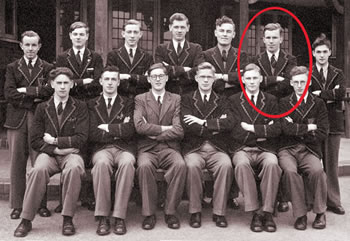 The Headmaster, W.D. Fraser died of a stroke whilst on a walking holiday in Scotland at Michaelmas half-term 1941. He was eventually succeeded by Harold Moodey in 1942.
The Headmaster, W.D. Fraser died of a stroke whilst on a walking holiday in Scotland at Michaelmas half-term 1941. He was eventually succeeded by Harold Moodey in 1942.
Mr Moodey was an Oxford graduate (Chemistry) as per regulations, and probably secured his appointment by having recently had a book published on Analytical Chemistry. I am afraid I endeared myself to him by finding three errors in it.
In my time Mr Moodey never took a chemistry lesson, even when Nick Nicholson was ill. He concentrated on religious instruction, usually using the period to harangue pupils on their poor performance. One of his early acts was to change the house system from one where boys were allocated by area of the town or to the same house as their fathers had been in, to a random distribution. At a time of severe clothes rationing this made him very popular.
Not mentioned so far are Hilda Press; she was a thug who taught French. I am sure many B form members will remember being whacked on the back of the head by this virago. There was also Norman Cleave who returned after the war (Tank group commander) to resume his post as senior English master but left after a term, to become headmaster of Poole Royal Grammar School. In his absence the English posts had been filled by Jake Hammond and Cyril ‘the weed’ Edlin. Cleave taught the Lower Sixth Science Logic for one term. I believe woodwork was abandoned in 1942 due to lack of materials, After the departure of Davis, the subject was taken over by Jenkins who also taught Latin. This master left in 1942 and Jake Hammond took over Latin.
Chemistry was not taught until one reached form 2, George Cooper took us for our first year, his degree was in Chemistry despite being Senior Maths Master. George always played the piano for assembly and the organ at Speech Day, etc. He was organist at Horninglow Methodist Church. Bill Read, Jake Hammond and Ronny Illingworth favoured the Wyggeston Hotel as their watering hole. Unfortunately Bill, who lived at the top of Foston Avenue, was found asleep in the front garden of a member of 4b halfway home, this took some living down.
Tom Parkin achieved notoriety by standing up in the middle of a church sermon and accusing the vicar of using the pulpit as a coward’s castle. He retired at the end of the war to be succeeded by Shorthose (the Drip-after an end of nose feature), another author. His book, ‘The Properties of Matter’ occupied 75% of the teaching time, but only 10% of the examination questions. He was the only master who came to school in a car, a Ford Popular, and had the distinction of being caught in the car in the middle of a level crossing with the gates closed. Schoolboys have eyes and ears everywhere.
Charlie Brown taught History and some Geography and was press ganged into teaching American history to 2A in 1942. He did this by reading a chapter in the text book during the preceding week then regurgitating it as a lesson. One week Charlie, always rather scatter brained, lost his text book. Charlie also kept bees and several times interrupted assembly with “Excuse me Headmaster, has any boy in the Field Lane area seen my bees?”
‘Old Nick’ Nicholson, an Irish communist, was the senior Chemistry master. He had previously been employed in industry which he left under a bit of a cloud. He was held responsible for a gas explosion in a large calciner which disintegrated. Chemistry lessons lasted two periods, for the first part, a lecture/demonstration, the class sat in a circle in an alphabetical order clockwise with Nick at 12 O’clock and Timber Woodcock at 11.30. Consequently Timber got the pleasure of sniffing any obnoxious gasses produced in the demonstration. There was one fire extinguisher, which after use, remained empty for a term.
In Harold Moodey’s time the procedure was for the extant prefects to send a list of preferred candidates for the next year to him, he then amended it. Up to the end of the 1940s prefects had a fair amount of power, they could set lines, put a persistent offender in detention and administer a smart clip on the ear. Discipline was pretty tight.
The War Years
Turning to the war years I started as one of twenty scholarship pupils in September 1941, eight from Grange Street eight from Horninglow Rd. four from the rest of Burton. The total of new entrants was made up to about forty, from the outside districts and the Prep form. The intake was lager than usual due to families moving out of Derby and Birmingham to the Burton area and commuting to their wartime jobs by bus or train. Their sons passed the entrance exam for paying pupils. We were divided into 1A form master Bill Read and 1B. We were taught identical lessons until the February exams and from the results reallocated to 1A&B. These results virtually governed whether you were in the ‘A’ or ‘B’ stream throughout your school career. This had the knock-on result that many of the brighter boys trapped by the scheme were removed and sent to the technical school in Guild Street. This school had a very good reputation thanks in part to the efforts of Arthur Blake, Burton’s very competent Director of Education.
School hours were 9.00 am till 4.05pm with lunch from 12.20 until 2.00pm. The problem of going home in the dark did not occur as single and double summertime were adopted throughout the war years. However detention was moved to Saturday mornings in the mid winter months. As a general rule school could start at 10.00 if the air raid warning had lasted for more than three hours in the preceding night. This was frequently the case in the winter of 1940 but not subsequently.
After school activities were severely limited in the winter months due to the blackout which despite the adoption of summer time, could be as early as 4.45. It was impossible to blackout the school though I think an attempt was made with A room and the adjoining corridors.
Their was also the deterrent of boys having to cycle home in the blackout and masters having to do fire-watching about once a week. An air raid shelter was constructed in the garden where U & V rooms were later constructed and several more in Peel Croft between the grand stand and Lichfield Street. They were relatively shallow shelters due to the possibility of flooding. I can only recall their use on one genuine occasion and several practises. Ironically the ATC’s uncamoulflaged Bulldog bi-plane was parked about 20 yards from the shelters.
Woodwork classes were abandoned in 1942 and with the advent of hit and run raids it was decided that the Art Room with its glass roof, was unsafe. This meant the loss of two class rooms and to compensate rooms were occupied in Bond St infants school which had been closed in 1939 and the Mission Hall in Bond End. As neither locations had an allocation of fuel, classes were conducted in gloves and overcoats. Infant size desks also caused problems. The Mission Hall was however successfully blacked-out, and was used by the Scouts, the ATC and the Aircraft Spotters Club. The Chess Club also functioned during the war years.
Most boys and masters came to school by cycle in all weathers. If it rained or snowed it was impossible to get on the buses unless you lived within two stops of the terminus. Waterproof capes and leggings were in short supply and required clothing coupons for purchase, so assembly and the first lesson were frequently accompanied by a steamy atmosphere. The school yard was surrounded by cycle racks, mostly undercover. All were numbered and you were allocated a number for the year. Cycles had to be pushed along Bond Street and mounted in Lichfield Street. Lichfield Street had to be crossed by the pedestrian crossing. Scooting on one pedal across the Ferry Bridge was not permitted and detention was the punishment.
In common with other schools the toilets were outside and froze in winter, smoking in the toilets was a caneable offence. Gas masks had to be carried from lesson to lesson until 1944 when regulations became less stringent. The school bell, traditionally rung by the weeks duty prefect, was not rung between 1940 and 1944.
Sport took its usual pattern during the war except that rowing had been abandoned. Rugby was played in the Autumn term and the first few weeks of the Spring term. House matches were played on Peel Croft as Burton rugby club was not functioning. Inter-school matches on Wednesdays and Saturdays were played at Senior and Junior level, travel usually being by Stevenson’s yellow peril. Cricket was also played at the same levels. Amongst the school opponents were:-Lichfield GS, Coton College,Denstone College,Uttoxeter GS, Burton Tech., Ashby GS, Newport GS, Trent College, King Edwards GS Aston & Five Ways, Radcliffe College, Nottingham High Pavement GS, Nottingham GS, Tamworth GS. Some fixtures were cricket only. Photo’s of the Cricket 1st XI are confusing, in general they were taken of the XI chosen for the Old Boys match which began at 11 am and frequently coincided with A level exams. This explains why a number of stalwarts are missing.
The school had a very strong swimming team and thrashed most opponents, the climax came in 1948 with a match against Motherwell GS which we narrowly lost. The opponents had three team members who subsequently swam in the London Olympic Games.
Cross country was the main athletic event in the second half of the spring term. The senior course started on the Ox Hay, then across the Ferry Bridge, through the back streets of Stapenhill, up to Brizlincote Hall Farm, across to Winshill Clump, down Tower Road and Ashby Road to Elms Road; across Stapenhill Road, through the Riverside Gardens and back to the Ox Hay via the Ferry Bridge. Track athletics were not taken very seriously until the arrival of Norman Jones and Norman Paine after the war.
The easing of blackout restrictions in 1944, lead to the renewal of evening activities. The Scouts held Gang shows in the school hall and the drama group got back into full swing.
The Fauld explosion has already been written about. There has been no mention of the fairground fire in 1943, which conveniently started at about 3.50 pm so had most ot he school as audience.
1945 saw many changes, partly due to the influx of new masters, contacts with the Girl’s High School previously fround upon were increased , initially with the Circle Francais (Wood),drama selection of plays with more female characters and by 1947 joint ballroom dancing classes. The cafe at the Ritz cinema also proved a great Saturday morning attraction.
E J Ward (Ernie as we new him then) partially took over rugby from Jake Hammond though there was a slight problem as Ernie had played the dreaded Rugby League as scrum-half for Bradford Northern. The opposition consequently received an unpleasant surprise. ernie also ran the radio society which operated from the sports pavilion, he had a very early so attracted a lot of contacts on the air waves.
There was also a man called Paine about 6’4″ tall, ex-Nottingham University, who took over part of Ronnie Illigworth’s cricket for a time. He lived up to his name, if you dropped a catch , mis-fielded or bowled a wide you were sent to run round the boundary several times.
Norman Jones boosted the interest in athletics and organised a visit to the 1948 Olympic Games. At that time you accumulated points for your house by acheivng a certain standard.
On Sports Day points were also awarded for the positions in the races and the house with the highest aggregate of the combined set of points won the cup. David (Spike) Finch who was Athletics Captain of Drake house caused some embarassment by turning out his house members to achieve the standards to such an extent that the difference between Drake’s pre Sports Day total and that of the other houses could not be made up by results on the day. Another entertaining incident was when Norman introduced and demonstrated the hammer. He got it wrong somehow and the hammer finished in the circle and Norman on his back outside. He had some diffculty in persuading Ronnie Illingworth that those spectators who applauded the effort should not be put in detention. It was quite noticeable that the attitude to the boys, of most of the post 1945 staff arrivals differed considerably from the pre-war ones.
The diagram of the lay out of the school is correct for the late 1940s except that L room was not divided fom the Art Room and J room was the home of 2a Charlie Brown in charge in the early 40s. Incidentally the photo Pre-World War II b is of the Art room not the Woodwork Room. In the early 40s the other form rooms were 1A in F (Frank Reed),4A in G (R Illingworth), 5A in C (H Pitchford), 2B in L, 3B in M (J Daffern), 4B in D (H Press) 5B in B ( J Hammond) Lower 6th Modern in N 6th Science in O (G Cooper). On completion of S and T rooms 2B went to S and the Lower 6th Science to T.
T room was fitted out with a demonstration bench, gas and water taps and basin, though it waas rarely used for its original intention as a supplementary physics lab.. However the was a perforated ventilation brick in the wall between between T and S and in free periods it was not unknown for a fine spray of water to be directed via a rubber tube and the ventilation brick on to the head of the master teaching in S room. It was surprising how often the roof of S room was examined for leaks.
Another feature of S and T rooms was the coke stove, totally inadequate in winter but stoked enthusiasically by the inmates to such an extent that the chimney often glowed red hot. On one occasion a small oxygen cylinder was left in T room, so it was decided that supplementing the air with oxygen would boosted the efficiency of the stove. The experiment was abandoned when the chimney softened and sank several inches.
Prefects and masters did one week on duty per term, this involved opening the garden gate, patrolling the school yard at breaks, tolling the school bell and reading the lesson (getting told off by H Pitchford if you said Jerusalum instead of —lem). In general prefects were allocated to individual forms for one term at a time and were expected to keep order in the absence of the master. They also did Dinner Duty once every three weeks supervising setting up and removing of tables etc.. Sandwiches were eaten in D room which was also used for pupils excused prayers.


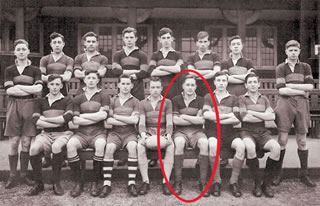 I was evacuated from my home in Manchester in August 1939 to live with my maternal Grandfather, R.W. Clubb who was a long-retired Head Cooper at Bass’s Brewery. When my sister Helen and I came to live with him at 6 Brizlingcote Lane we were 10 and 11 respectively and he was about 87, a widower with living-in housekeeper.
I was evacuated from my home in Manchester in August 1939 to live with my maternal Grandfather, R.W. Clubb who was a long-retired Head Cooper at Bass’s Brewery. When my sister Helen and I came to live with him at 6 Brizlingcote Lane we were 10 and 11 respectively and he was about 87, a widower with living-in housekeeper.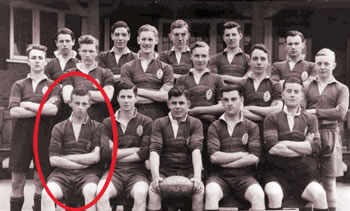 School started with assembly in the hall under the eagle eye of Tom Parkin. The Headmaster read a prayer, a hymn was sung, notices read and then quietly and orderly we left for our classrooms. Breaktime we went across Bond Street to the Rawlings sisters (Gertie & Maisie) where if you were lucky, you bought a doughnut or a twist. Back to school until Dinner time from 12:00am to 1:30pm and finally home at 4:00pm
School started with assembly in the hall under the eagle eye of Tom Parkin. The Headmaster read a prayer, a hymn was sung, notices read and then quietly and orderly we left for our classrooms. Breaktime we went across Bond Street to the Rawlings sisters (Gertie & Maisie) where if you were lucky, you bought a doughnut or a twist. Back to school until Dinner time from 12:00am to 1:30pm and finally home at 4:00pm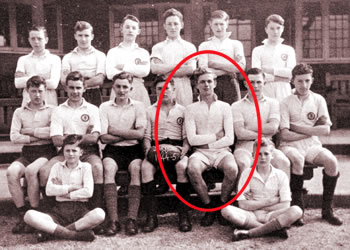 Having been bombed out in London’s East End in 1941, I was evacuated with my brother Dennis and my Mother to Newhall near Burton. We were billeted in a very small cottage in the back gardens of homes in Oversetts Rd. “Grandy Sabin one of the characters of Newhall was the tenant. He lived and slept in one downstairs room whilst we used all the other rooms. There was no bathroom and an outside toilet. The downstairs rooms must have been infested with cockroaches because if we returned home at night and switched the lights on there was a very large gathering of them in the middle of the floor! My primary school was in Newhall. In 1942 I had to take the London County Council entrance examination at the primary school and the paper was sent to the London Education Authority for assessment. Due to administrative delays my results were not processed until October 1942 and I was awarded a special place at Burton Grammar School; my London grammar school would have been Coopers Company Boys School in East London.
Having been bombed out in London’s East End in 1941, I was evacuated with my brother Dennis and my Mother to Newhall near Burton. We were billeted in a very small cottage in the back gardens of homes in Oversetts Rd. “Grandy Sabin one of the characters of Newhall was the tenant. He lived and slept in one downstairs room whilst we used all the other rooms. There was no bathroom and an outside toilet. The downstairs rooms must have been infested with cockroaches because if we returned home at night and switched the lights on there was a very large gathering of them in the middle of the floor! My primary school was in Newhall. In 1942 I had to take the London County Council entrance examination at the primary school and the paper was sent to the London Education Authority for assessment. Due to administrative delays my results were not processed until October 1942 and I was awarded a special place at Burton Grammar School; my London grammar school would have been Coopers Company Boys School in East London.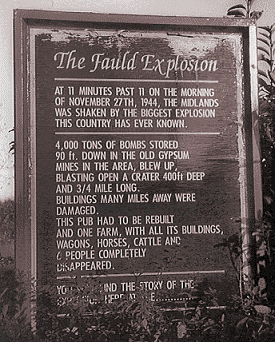 It was just after 11 o’clock on a foggy Monday morning,the 27th November 1944. As a ten year old boy I sat at my desk in ‘A’ room at the Burton Grammar School. I thought that I was about to faint. Without any noise at all my desk seemed to rise up towards me, or perhaps I was going down towards it. A very strange sensation was soon gone but quickly the whole class realised we had all experienced the same feeling. From the floor upstairs came a noise of the whole class there scrambling under their desks. Around lunchtime the rumours were well established and it was only later that we found out that the ‘Dump’ had gone up.
It was just after 11 o’clock on a foggy Monday morning,the 27th November 1944. As a ten year old boy I sat at my desk in ‘A’ room at the Burton Grammar School. I thought that I was about to faint. Without any noise at all my desk seemed to rise up towards me, or perhaps I was going down towards it. A very strange sensation was soon gone but quickly the whole class realised we had all experienced the same feeling. From the floor upstairs came a noise of the whole class there scrambling under their desks. Around lunchtime the rumours were well established and it was only later that we found out that the ‘Dump’ had gone up.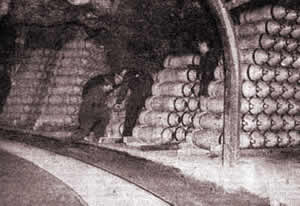 On the way home I stopped to take train numbers but there was still a dense fog and we heard the endless sounds of emergency vehicles going to the local hospital that was just down the road from us. I remember the eerieness of everything drove me home.
On the way home I stopped to take train numbers but there was still a dense fog and we heard the endless sounds of emergency vehicles going to the local hospital that was just down the road from us. I remember the eerieness of everything drove me home.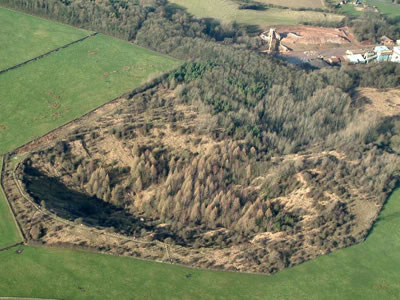 Sixty-eight people lost their lives in a bang which took out the crater, (which was some 90 feet deep and covering an area of 12 acres) in a second. A whole farm with buildings implements and stock vanished without trace. A thousand acres of topsoil was redistributed, some up to 11 miles away.
Sixty-eight people lost their lives in a bang which took out the crater, (which was some 90 feet deep and covering an area of 12 acres) in a second. A whole farm with buildings implements and stock vanished without trace. A thousand acres of topsoil was redistributed, some up to 11 miles away.